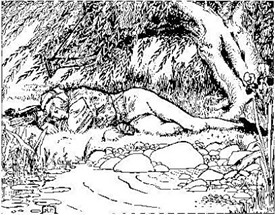Robin Hood's Well

Alan-a-Dale lieth beside the fount
Howard Pyle
A healing well
By R B Parish
Surprisingly considering the association of the legend with Nottinghamshire, there are compared to Yorkshire, few wells associated with the well known folk hero. Indeed, the only surviving site is now slowly being lost to time perhaps, inaccessible in private woodlands. This Robin Hood’s Well arises in a small area of private woodland not far from the remains of a noted Carthusian Priory which are now incorporated into a farm.
A local custom
Marson (1965-6) notes that on Midsummer Eve local people would dance there, the space around it being kept as a lawn, an open space in the woods. When this happened and whether there was any significance to the date is not recorded but Marson (1965-6) notes that when the site was turned to a pheasant reserve, the lawn was allowed to grass over and the dancing ceased.
D.H. Lawrence connection
Old photographs show a rectangular summer house, called the Gamekeepers Hut with a tiled room supported by two thin columns. This appears to be subdivided; the later enclosed area which presumably covered the well although the well itself is not shown. The summer house is pictured in a small opening in the woods, it was the gamekeepers hut in D. H. Lawrence's ‘Lady Chatterley's Lover’ and would appear that in the early part of the last century the site was a tourist attraction.
A ruined structure
As this opening has long grown over, and the summer house slowly lost to the undergrowth and virtually destroyed, but the well remains. Now a sluggish spring arises to flow into a mossy oval basin which is reached by steps down to one side. Old photos show a considerable stream flowing into this basin and out into the stream below suggesting that the spring has been affected by a lowering of the water table hereabouts. Of the summer house only the foundations remain, part of which encloses the spring in a square chamber. The stone work is difficult to date but as a survey in 1954 notes probably not mediaeval.
Curative waters
Its waters were thought to be curative and an aphrodisiac, suggesting an earlier holy association or a possible pagan one! Certainly, the water was used by the priory and it was carried via open streams round the outside wall of the cloister gardens, feeding a large fish pond on the east, near the gate-house. Water was then laid on in leaden pipes to each cell, possibly from a conduit or cistern.
References:
Extracted and amended from R.B. Parish (2010) holy wells and healing springs of Nottinghamshire
Thanks to holywell@www.megalithic.co.uk for the photos